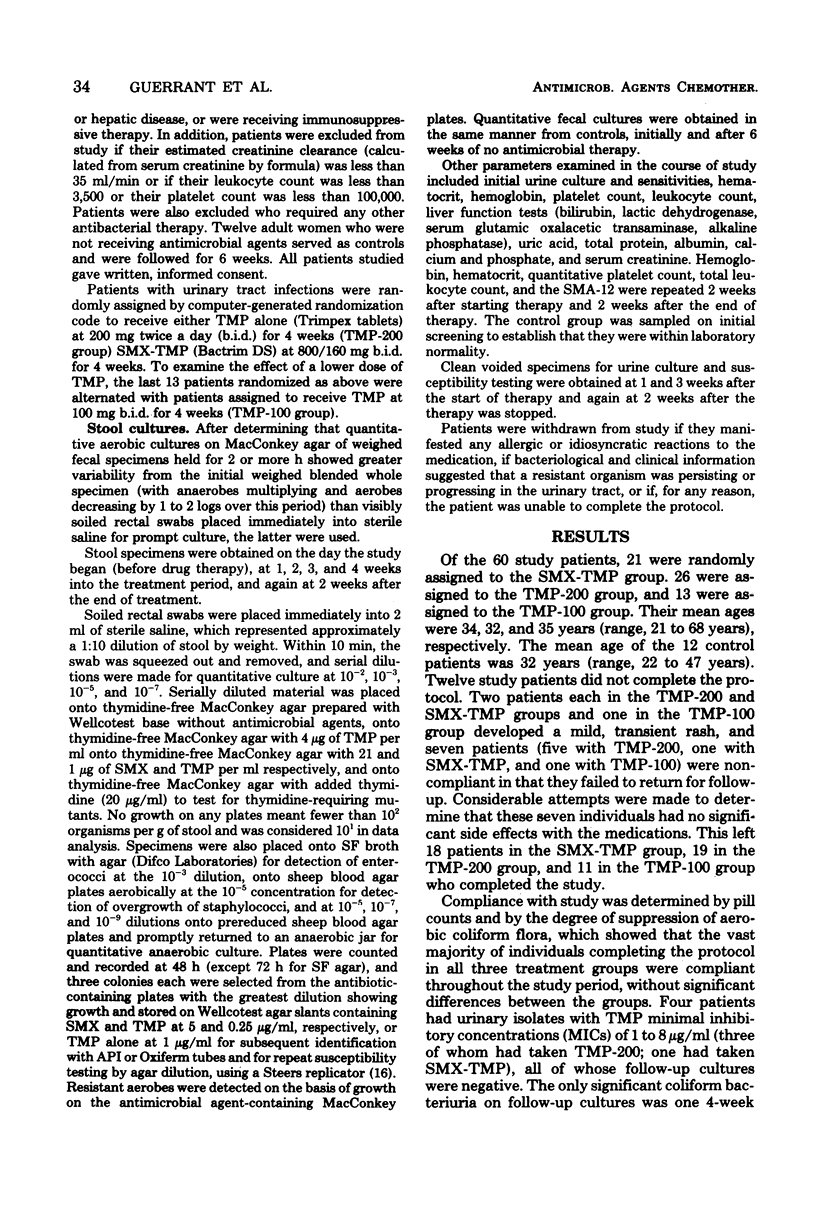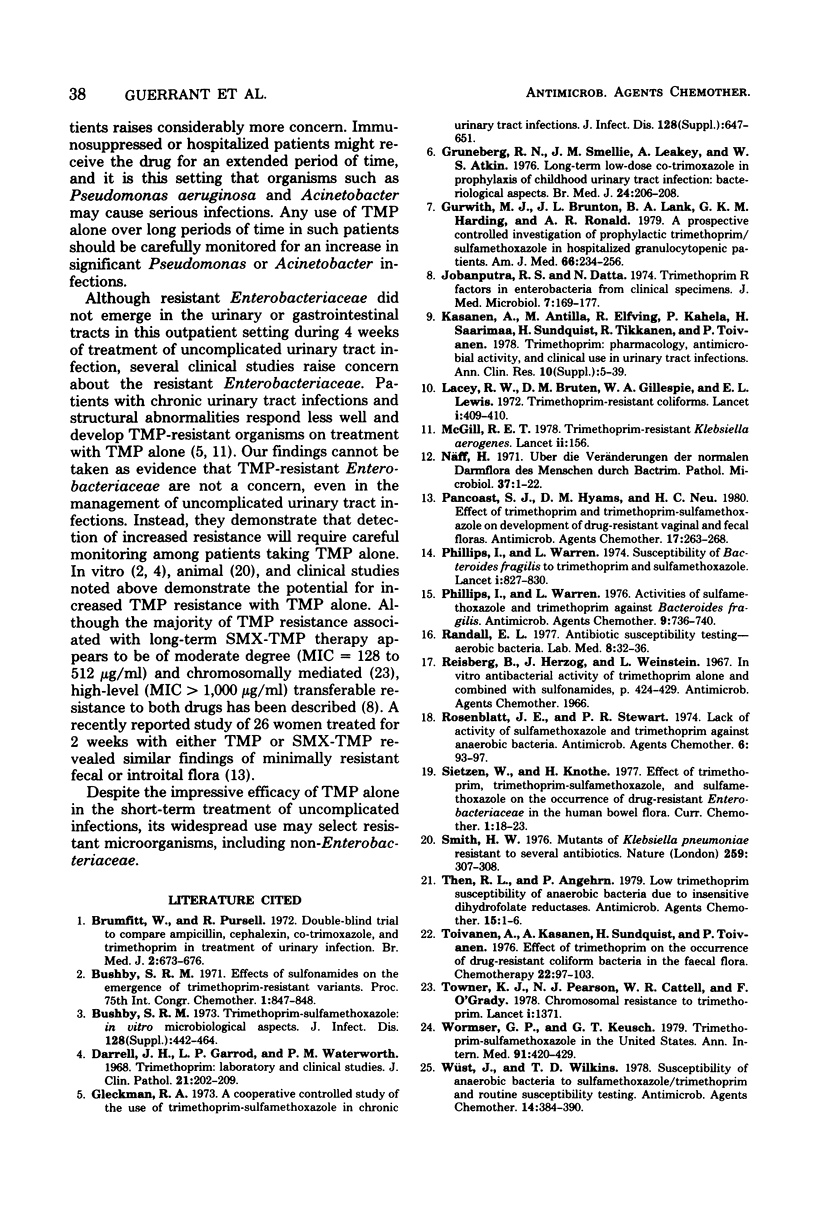Abstract
Because of the widespread occurrence of resistance to sulfonamides among Enterobacteriaceae, some researchers have suggested using trimethoprim (TMP) alone instead of the combination sulfamethoxazole-trimethoprim (SMX-TMP) in treating infections with TMP-susceptible organisms. To answer whether SMX-TMP suppresses the emergence of resistant organisms compared with TMP alone, quantitative fecal cultures were made for total and TMP-resistant organisms before, during, and after SMX-TMP (800/160 mg twice a day) or TMP (200 or 100 mg twice a day) was given to 48 patients for 4 weeks in a prospective, randomized study. All three regimens left anaerobes intact and reduced the total aerobic coliform fecal flora by approximately 4 logs throughout the 4-week treatment period. In 11 of 19 (58%) patients taking TMP 200 mg twice daily, TMP-resistant organisms emerged or increased during therapy (P less than 0.01, compared with none of the 12 controls), whereas in only 4 of 18 (22%) patients on SMX-TMP did TMP-resistant organisms increase. These TMP-resistant organisms increased by less than 1 log and were predominantly Pseudomonas and Acinetobacter species. In only one instance did an SMX-TMP-resistant Escherichia coli strain emerge after 4 weeks of SMX-TMP therapy. The slight increase in Pseudomonas and Acinetobacter species seen with TMP alone in this study raises a potential risk of giving TMP alone in settings where these organisms may cause serious infections, as in immunosuppressed patients.
Full text
PDF





Selected References
These references are in PubMed. This may not be the complete list of references from this article.
- Brumfitt W., Pursell R. Double-blind trial to compare ampicillin, cephalexin, co-trimoxazole, and trimethoprim in treatment of urinary infection. Br Med J. 1972 Jun 17;2(5815):673–676. doi: 10.1136/bmj.2.5815.673. [DOI] [PMC free article] [PubMed] [Google Scholar]
- Bushby S. R. Trimethoprim-sulfamethoxazole: in vitro microbiological aspects. J Infect Dis. 1973 Nov;128(Suppl):442–p. doi: 10.1093/infdis/128.supplement_3.s442. [DOI] [PubMed] [Google Scholar]
- Darrell J. H., Garrod L. P., Waterworth P. M. Trimethoprim: laboratory and clinical studies. J Clin Pathol. 1968 Mar;21(2):202–209. doi: 10.1136/jcp.21.2.202. [DOI] [PMC free article] [PubMed] [Google Scholar]
- Gleckman R. A. A cooperative controlled study of the use of trimethoprim-sulfamethoxazole in chronic urinary tract infections. J Infect Dis. 1973 Nov;128(Suppl):647–p. doi: 10.1093/infdis/128.supplement_3.s647. [DOI] [PubMed] [Google Scholar]
- Grüneberg R. N., Smellie J. M., Leakey A., Atkin W. S. Long-term low-dose co-trimoxazole in prophylaxis of childhood urinary tract infection: bacteriological aspects. Br Med J. 1976 Jul 24;2(6029):206–208. doi: 10.1136/bmj.2.6029.206. [DOI] [PMC free article] [PubMed] [Google Scholar]
- Gurwith M. J., Brunton J. L., Lank B. A., Harding G. K., Ronald A. R. A prospective controlled investigation of prophylactic trimethoprim/sulfamethoxazole in hospitalized granulocytopenic patients. Am J Med. 1979 Feb;66(2):248–256. doi: 10.1016/0002-9343(79)90539-4. [DOI] [PubMed] [Google Scholar]
- Jobanputra R. S., Datta N. Trimethoprim R factors in enterobacteria from clinical specimens. J Med Microbiol. 1974 May;7(2):169–177. doi: 10.1099/00222615-7-2-169. [DOI] [PubMed] [Google Scholar]
- Kasanen A., Anttila M., Elfving R., Kahela P., Saarimaa H., Sundquist H., Tikkanen R., Toivanen P. Trimethoprim. Pharmacology, antimicrobial activity and clinical use in urinary tract infections. Ann Clin Res. 1978;10 (Suppl 22):1–39. [PubMed] [Google Scholar]
- Lacey R. W., Bruten D. M., Gillespie W. A., Lewis E. L. Trimethoprim-resistant coliforms. Lancet. 1972 Feb 19;1(7747):409–410. doi: 10.1016/s0140-6736(72)90857-4. [DOI] [PubMed] [Google Scholar]
- McGill R. E. Trimethoprim-resistant Klebsiella aerogenes. Lancet. 1978 Jul 15;2(8081):156–156. doi: 10.1016/s0140-6736(78)91541-6. [DOI] [PubMed] [Google Scholar]
- Näff H. Uber die Veränderungen der normalen Darmflora des Menschen durch Bactrim. Pathol Microbiol (Basel) 1971;37(1):1–22. [PubMed] [Google Scholar]
- Pancoast S. J., Hyams D. M., Neu H. C. Effect of trimethoprim and trimethoprim-sulfamethoxazole on development of drug-resistant vaginal and fecal floras. Antimicrob Agents Chemother. 1980 Feb;17(2):263–268. doi: 10.1128/aac.17.2.263. [DOI] [PMC free article] [PubMed] [Google Scholar]
- Phillips I., Warren C. Activity of sulfamethoxazole and trimethoprim against Bacteroides fragilis. Antimicrob Agents Chemother. 1976 May;9(5):736–740. doi: 10.1128/aac.9.5.736. [DOI] [PMC free article] [PubMed] [Google Scholar]
- Phillips I., Warren C. Susceptibility of Bacteroides fragilis to trimethoprim and sulphamethoxazole. Lancet. 1974 May 4;1(7862):827–829. doi: 10.1016/s0140-6736(74)90481-4. [DOI] [PubMed] [Google Scholar]
- Rosenblatt J. E., Stewart P. R. Lack of activity of sulfamethoxazole and trimethoprim against anaerobic bacteria. Antimicrob Agents Chemother. 1974 Jul;6(1):93–97. doi: 10.1128/aac.6.1.93. [DOI] [PMC free article] [PubMed] [Google Scholar]
- Smith H. W. Mutants of Klebsiella pneumoniae resistant to several antibiotics. Nature. 1976 Jan 29;259(5541):307–308. doi: 10.1038/259307a0. [DOI] [PubMed] [Google Scholar]
- Then R. L., Angehrn P. Low trimethoprim susceptibility of anaerobic bacteria due to insensitive dihydrofolate reductases. Antimicrob Agents Chemother. 1979 Jan;15(1):1–6. doi: 10.1128/aac.15.1.1. [DOI] [PMC free article] [PubMed] [Google Scholar]
- Toivanen A., Kasan A., Sundquist H., Toivanen P. Effect of trimethoprim on the occurrence of drug-resistant coliform bacteria in the faecal flora. Chemotherapy. 1976;22(2):97–103. doi: 10.1159/000221918. [DOI] [PubMed] [Google Scholar]
- Towner K. J., Pearson N. J., Cattell W. R., O'Grady F. Chromosomal resistance to trimethoprim. Lancet. 1978 Jun 24;1(8078):1371–1371. doi: 10.1016/s0140-6736(78)92456-x. [DOI] [PubMed] [Google Scholar]
- Wormser G. P., Keusch G. T. Trimethoprim-sulfamethoxazole in the United States. Ann Intern Med. 1979 Sep;91(3):420–429. doi: 10.7326/0003-4819-91-3-420. [DOI] [PubMed] [Google Scholar]
- Wüst J., Wilkins T. D. Susceptibility of anaerobic bacteria to sulfamethoxazole/trimethoprim and routine susceptibility testing. Antimicrob Agents Chemother. 1978 Sep;14(3):384–390. doi: 10.1128/aac.14.3.384. [DOI] [PMC free article] [PubMed] [Google Scholar]


